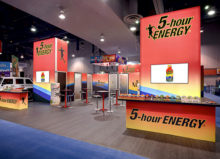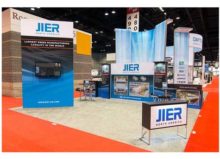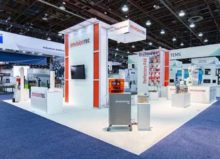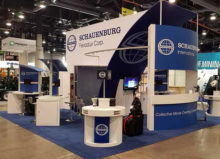Create an Effective Exhibit Design
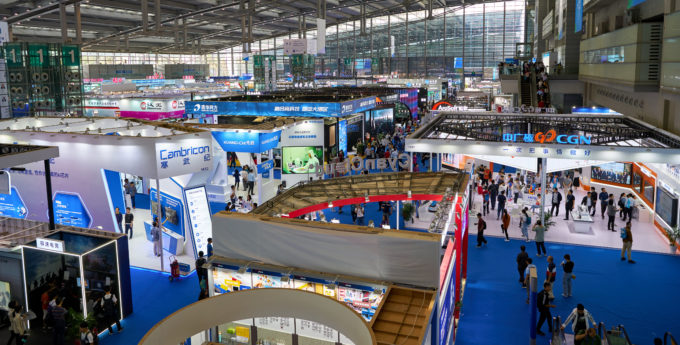
If you haven’t been attending trade shows—you’re missing out on many advantages. First, trade shows are a great way to meet thousands of potential customers. They’re also excellent opportunities to network with possible partners and meet industry movers and shakers. Lastly, trade shows give you the chance to size up your competition, and potentially get new ideas for your company.
However, the advantages you see from a trade show largely depend on the quality of your exhibit. So, what impacts the quality of an exhibit design?
What Makes a Trade Show Exhibit Effective?
Effective trade show exhibits don’t just happen by accident; they require careful planning. The first step in creating an effective exhibit is to plan the design around your target audience.
First, your exhibit design must be noticeable from a distance, as potential buyers may be anywhere in the venue.
Secondly, your exhibit needs to have honest and accurate brand messaging; within seconds, your audience should be able to grasp the gist of who you are and what you do.
Lastly, your exhibit must stand out from the competition. If you’re just copying the design of a competitor, you’re showing your audience that you’re not bringing anything new to the table.
To sum it up—an effective trade show exhibit accurately defines who you are and what you do, uses design techniques and technology that’s best for your target audience (think about digital displays versus traditional paper media like brochures and flyers), and does not copy other exhibits at the trade show.
The Dos and Don’ts of Design
Now that you know the three major factors that affect an exhibit’s success, let’s discuss some of the primary dos and don’ts of design:
- Table Throw Versus Banner Stand – DO use a banner stand. A table throw displaying your branding can be good for some events, but in general, putting your signage on a high stand-up banner display is better for visibility with the larger crowds typical at trade shows.
- iPad Stand Versus Mounted Monitor – DON’T use a mounted monitor. It’s a great idea to add some interactive technology to your booth, including video, but unless you have a large space to work with, a small standing iPad display will fit better than a larger wall monitor.
- Brochure Stand Versus Display Table – DO utilize brochure stands. When compared to display tables, brochure stands save space, increase visibility, and look more professional and organized.
- Counter Versus Chairs – DO add standing counters. Unless your exhibit features on-site registration or signups, use standing counters over chairs. A standing counter improves visibility and keeps your reps active and on their feet.
Factors to Consider When Planning Your Exhibit
When creating your exhibit design, you’ll also want to keep a few factors in mind:
Budget
One of the most common mistakes first-time exhibitors make is not properly budgeting. In addition to deciding what type of technology and equipment you’ll utilize in your exhibit, you also need to think about:
- Floor space: This determines the size of booth you can afford
- Displays: Do you need to rent one or purchase one? The best way to decide this is to determine how many trade shows you plan on attending. For more information, please read our recent blog post on trade show displays.
- Volunteers: How many people are you going to need to man the space?
- Drayage: This is the most expensive mistake first-timers make. Venues always charge exhibitors a fee for handling (unloading and loading) materials from the venue dock to your booth. This fee is not negotiable and varies from venue to venue. Always be sure you know what the drayage fees are.
- Transportation: In addition to drayage costs, there’s also the cost of transportation. Always consider that when booking a trade show that’s happening out of your home state.
- Marketing materials: Will you give out free prizes? Are you going to have paper media in your exhibit? Are you launching new products?
- Hotel & Gas: If your trade show is far away, you’ll also need to consider the number of days you need to stay at a hotel, as well as how much and often you’ll be driving.
Booth Space & Location
As we mentioned earlier, every venue is different. Be sure you know the full layout of the venue before booking a trade show. This will help you understand traffic patterns and know which spot is the best. You also need to ensure that the location you’re choosing is not close to a vulnerable competitor.
General Exhibiting Tips
You have a great exhibit design…now what? After you’ve planned, designed, and created your exhibit, follow this checklist to ensure trade show success:
✔ Have an exhibition manager: Make sure you have one person in charge of managing the exhibition, creating a contingency plan, and creating an itemized list of everything in your exhibit. If you have personally invited people to this trade show, the exhibition manager will also make sure there is reliable transportation for them, as well as food and drinks.
✔ Promote your attendance: Be sure to promote your presence at the trade show. You can write pre-show press releases (be sure to get them sent out at least a month in advance), advertise the trade show on social media, include it in newsletters sent to your email subscribers, and send out mailers and flyers in your community. Another idea is to send out complimentary tickets to new business or loyal clients.
✔ Keep a calendar at your booth: When potential buyers view your exhibit, you’ll want to make sure you have their contact information so you can schedule a follow-up call with them.
✔ Bring a catalog: If you’re selling products, you can’t bring all of them with you to the trade show. Showcase the products you want to sell the most, but also have multiple catalogs available in your booth for potential buyers to look through. This catalog could be paper or part of a digital display.
✔ Have inquiry forms and business cards: In addition to having customer contact information, you’ll also want to make sure that they know how to contact you.
✔ Check out your competition: While at the trade show, don’t be afraid to check out your competition. You’ll want to report everything you find to relevant people within your company.
✔ Make sure new products are secure: If you’re displaying ground-breaking products, especially ones that are patent-pending, you will need to take security very seriously. Keep them inside a display box, or make sure someone is supervising them at all times.
✔ Follow-up with interested customers: Don’t delay contacting interested customers! We recommend starting the follow-up process within three days after the trade show. Follow-up methods include sending thank you cards to people who visited your booth, sending emails to customers who filled out inquiry forms, and offering incentives to potential customers.
Learn More About Planning & Designing Trade Show Exhibits
Have questions about designing an exhibit? Let GraphiColor help! Our award-winning team has over 40 years of experience designing and building unique trade show exhibits for clients in a wide array of industries. To learn more about how we can help you, contact us today for a free design consultation.




